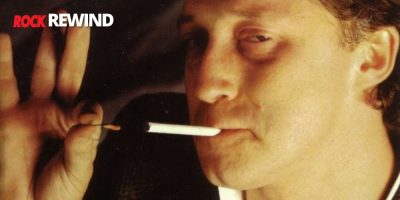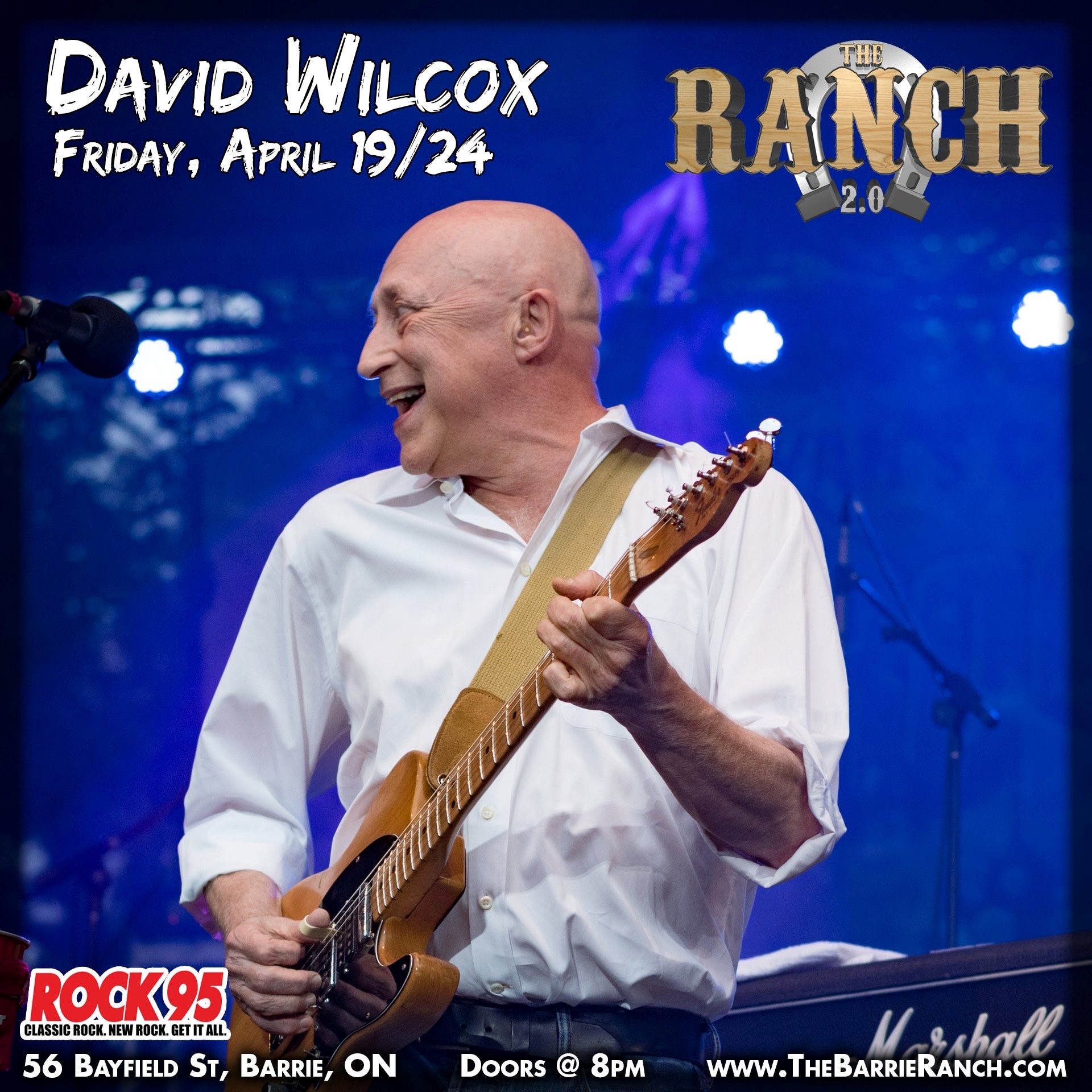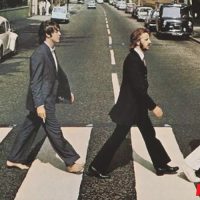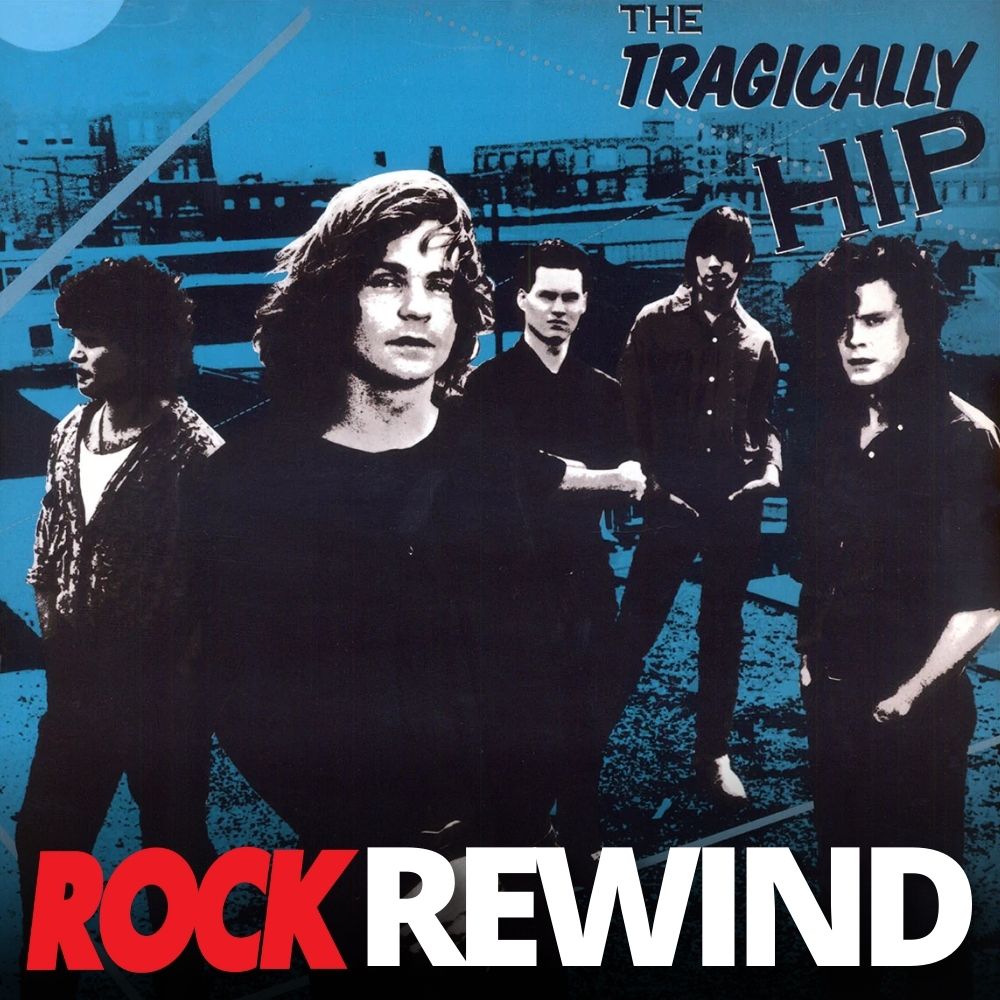Rock Rewind: The Guitar-Driven Sound Of David Wilcox
David Wilcox is a Canadian rock musician known for his distinctive guitar skills, thoughtful (and […]
David Wilcox is a Canadian rock musician known for his distinctive guitar skills, thoughtful (and often time humorous) lyrics, and smooth baritone voice. This year he will be performing at the Rock 95 Birthday Bash, along with Sloan and Finger Eleven.
For many, his music resonates as a timeless soundtrack that has accompanied them through various chapters of life.
Born on July 13, 1949, in Montreal, Wilcox has carved out a lasting legacy in the world of rock music. Let’s rewind the clock and explore the journey of this legendary artist.
Early Days and Musical Roots
Wilcox’s love of music began at an early age. By the age of 6, he was already finding inspiration in artists like Elvis Presley.
In an interview, Wilcox shares, “ I’m old enough to have remembered when Elvis came out and he really impressed me deeply. I thought he was fantastic. The girls liked him and what did Elvis have? A guitar. (laughs) So I got one. And then after that, everything from Buddy Holly to The Beatles really impressed me too. And then I liked the blues guys like Robert Johnson and Blind Lemon. So, a wide variety.”
At 7, he had started playing guitar and when he was 14, he performed his first live show to a room of ex-convicts. According to Wilcox’s recollections, the audience wasn’t overly impressed …
“It was pretty funky. I remember they threw chairs at us and stuff like that. ‘Donna’, by Richie Valens, that was our big number back then,” Wilcox recalled in an interview.
His dedication to the guitar led him to explore various musical styles, with a particular fondness for blues and rock.
In 1970, David Wilcox started performing with Ian and Sylvia Tyson as part of their band, Great Speckled Bird, on the Ian Tyson Show. The band performed backup for many artists including Anne Murray, Carl Perkins, Charlie Rich, John Paul Jones, and more.
In an interview with McCully, Wilcox shares, “I owe Ian a debt I can never repay. He gave me my first real chance in the music business. I went from playing in my mother’s basement in North York to touring internationally with Ian and Sylvia … they taught me so much about music, and professionalism, and life.”
In 1973, after recording two records with Great Speckled Bird, Wilcox left the band. Over the next few years, he would go on to play and record with the Rhythm Rockets and Maria Muldaur.
In 1975, Wilcox started a rock trio called the Teddybears. The band played at nightclubs and universities across Canada. When performing, he donned a baggy suit, waxed mustache, and flowered lapel.
This period was crucial for his growth as an artist, as he fine-tuned his skills and developed a deep connection with his instrument. It was evident even then that he had something special to offer to the world of music.
The turning point in David Wilcox’s career came in 1982 when he signed on with Capitol Records.
Over the years, David Wilcox has continued to make a mark on the music industry with a substantial body of work. His discography includes a range of studio albums, live recordings, and collaborations.
Each album showcases his evolution as an artist and his commitment to pushing the boundaries of his craft. Wilcox’s music has a timeless quality to it, transcending the confines of a particular era. It’s not uncommon to find fans of all ages who connect with his music, a testament to its enduring appeal.
David Wilcox’s Signature Sound
While his music evolved over the years, it remained a fusion of rock, blues, and folk.
What sets David Wilcox apart from the crowd is his unmistakable sound.
His guitar playing often features open tuning and customized capos, which are techniques that he has mastered throughout his career. But what really makes his playing stand out is the emotion he creates with his playing.
In a 2019 interview, Wilcox about playing from the heart. “That’s what I want. That’s what I’m aiming for, rather than just a sort of technical exercise, just running notes. I really try to make it speak and really try to give it that deep integrity, if I can.”
Vocals are another integral component of his signature sound. His voice, characterized by its raspy quality, has a unique ability to convey the depth of his lyrics.
While his music includes numerous catchy, tongue-in-cheek, fun hits, his lyrics also delve into the complexities of love, the struggles of life, and the journey of self-discovery.
In his more serious pieces, you can feel the emotion behind every word. It’s this authenticity that resonates with his audience and creates a lasting connection, even when he’s simply teaching us how to “Do The Bearcat.”
David Wilcox Discography
Since going solo in 1977, David Wilcox has put out:
5 compilation albums – The Best Of David Wilcox (1985), Over 60 Minutes With … David Wilcox (1987), The Collected Works 1977-1993 (1993), Greatest Hits Too (1997), Rockin’ The Boogie: The Best Of Blues And Boogie, and Icon (2013)
He’s also released 8 studio albums …
1. Out Of The Woods (1977)
David Wilcox’s first album was Out Of The Woods. The album was produced by Sadia Sadia, a Canadian-born artist known for her audiovisual work and art installations.
Unable to get a record company to sponsor Wilcox’s first album, Sadia found him an investor. But even after the album was finished, it took another two years to sell it.
In 1977, Out Of The Woods was independently released with Freedom label in Toronto, where David Wilcox was raised.
The album showed off Wilcox’s talent as a songwriter and guitarist, as well as his quirky sense of humour.
In an interview, Wilcox explained, “Life is a humorous thing if one looks at it that way. I’m not a comedian per se, but I like to have a little bit of whimsical humour in there. Just to not get too serious.”
The album features 3 of Wilcox’s biggest hits – “Do The Bearcat,” “Bad Apple,” and “The Hypnotizin’ Boogie.”
“Hot, Hot Papa” is another track that fans go crazy for. During one show at the Forum drunken fans, made up mostly of bikers, rushed the stage.
“The bikers were literally hanging off of [David Wilcox] while he was playing, but he took it all in stride, adding new lines to the song about the unfolding scene while scanning around for security. In those days, the forum had only a small security staff and a few hired police officers working overtime, so removing the two dozen bikers proved to be a bit difficult. Worse still, Wilcox had asked the stagehands to set the stage rotation to its maximum speed, and so the apprehension of the staggering, lumberjacket-laden-biker-lumpen became a full circus act. As soon as the police had removed one biker from the stage, another one would magically appear. The slapstick just made the crowd go even wilder, and Wilcox and his band were feeding off the melee …” – The Basement Rug
After taking Freedom to court for not paying him, Wilcox signed with Capitol Records in 1982. Out Of The Woods was re-released in 1983 and went gold.
2. My Eyes Keep Me In Trouble (1983)
The same year, in 1983, Wilcox released My Eyes Keep Me In Trouble. The album title came from Wilcox’s cover of a Muddy Waters song of the same name.
My Eyes Keep Me In Trouble was his second straight gold record and featured the songs “Uptown Came Downtown” and “Riverboat Fantasy.”
While appearing on Behind The Vinyl, Wilcox shares some of the inspirations for “Riverboat Fantasy.”
“Originally there were several inspirations for it. One of them was that I have always been fascinated by the beginning of jazz because it was never recorded. There are lots of documentaries that describe the different influences that went into it but none of them account for what happened that created jazz music … so it’s something totally North American. My fascination with that led me to realize that it would have been possible to ride on a riverboat in 1894 with one of the great early jazz bands and a little companionship, some supplies, and have a heck of a party.”
Another inspiration for the song was time spent on Lake Muskoka playing music and drinking at a friend’s cottage. Some of the older guys in the group even built a raft with a trap door that opened to a built-in beer cooler.
The guitar used for the song’s solo was a “four pick up Japanese made early 60s guitar. The kind that has tons of knobs and stuff on it, most of which don’t do anything. It was my dream guitar when I was 13 and someone gave it to me years later. I could never use it live because it doesn’t intonate well but in the studio, cranked up, you could hear the tone.”
3. Bad Reputation (1984)
Wilcox continued his successful journey with the release of Bad Reputation. Like his previous releases, this album went gold.
Bad Reputation, like his previous albums, was produced by Sadia. Wilcox once shared, “The reason I asked her to produce me is because I trust her taste–she’s one of the few people I can lose a fight with over artistic or creative things, and still feel that the project isn’t threatened. It’s not like some Nazi going ‘Stand here. Wear this. And sing!’ She’s someone I can relate to on that level.”
4. Breakfast At The Circus (1987)
For Breakfast At The Circus, Wilcox moved away from edgy lyrics and a raw live-in-studio sound. Instead, he turned to modern rock, experimenting with more synthesizers and drum programming for a more produced record.
His lyrics and the overall compilation of his songs changed as well. When talking to Rock 95 about the evolution of his music, Wilcox shared:
“I did notice the songs changed. First, I was playing to audiences who had no idea who I was. You just go into a bar and play. You have no records, no airplay, no nothing. The thing is I had to have songs you could get in in the middle of the song and still feel like you were a part of it like a song like ‘Bump Up Ahead’. Or something like that where if you started in the middle you can still feel what it’s about. Later on, I could do songs that had an evolving story like ‘Layin’ Pipe’ or something like that where there’s a sort of progression in the verses.”
5. The Natural Edge (1989)
Wilcox continued with his modern rock sound when creating The Natural Edge. The album was further proof that the guitarist was able to round out a set list full of humour and catchy hits, with deep lyrics and emotion.
Following the album’s release, Toronto Star critic Craig McInnis said, “There have always been two David Wilcoxes. One is the fleet-fingered miscreant whose grungy guitar fantasies betray the instincts of an eternal teenager. The other is… a pensive, sympathetic figure with a keen eye for social detail and a well-developed sense of musical irony’
Notable songs off the album included “Ivory Tower” and “Still Life.”
6. Thirteen Songs (1996)
For Thirteen Songs, Wilcox focused on acoustic-based tracks with a small backup band. The songs of this album were a mix of formats and genres including jazz, blues, country, and storytelling.
While the cuts on this album showcased the fast-paced blues sound he had become known for, his playing had evolved and matured from earlier works. “Rainy Night Saloon” and “God Is On A Bender” are just two of the tracks from this self-produced album.
Following the album’s release, Wilcox moved from Capitol Records to Sony Plain Records.
7. Rhythm Of Love (2000)
With the release of Rythm of Love, Wilcox continued to blend genres but this time he introduced his first electric band. Produced by Colin Linden, who joined Wilcox’s band after quitting school, the album features incredible guitars, a mix of goofy and heartfelt lyrics, and soulful vocals.
The cover of the album features David Wilcox with his wood grain Telecaster. In an interview, Wilcox shares, “I bought it new in 1978 … so every little bump and nick on it is mine. I’ve had it all these years.”
When asked how he found his way to the Telecaster, Wilcox goes on to say, “It’s embarrassing … I thought it was cool. That’s the honest truth of it. I just thought it was a cool-looking guitar. But now I realize too that it’s sort of the best singer’s guitar, or one of them because it has one volume and one tone.
“A lot of the others have more than that so if you have to change something quickly while you’re thinking about singing it’s good for that. And obviously, it’s so versatile. I mean count the number of people who have played them. In country music, I mean Ed Bickert [plays] jazz on one. And blues players – Muddy Waters played one. So it’s a very versatile instrument.”
8. Boy In The Boat (2007)
Release by Sony Plain Records, Boy In The Boat is another of Wilcox’s self-produced albums.
Wilcox recalls, “I wanted to make a record as freely as possible. My first albums were done with no ‘adult supervision’; no concerns with current trends or ‘marketing’, just a group of people making music for the pure joy of it. With this one, we took that approach.”
He continues, “There is an afternoon I’ll always remember when I was a child – me and my little red Motorola radio. In the basement, if they played a record by a male singer I pretended it was me. If the singer was a woman I pretended I was the guitar player. Little did I know that I’d be blessed with a career in music! Years later that memory sustains me, keeping my pure love of music alive. If I ever start feeling jaded or pressured to conform, that kid lost in the music brings me back to myself.”
Live Performances
One of David Wilcox’s strengths as an artist lies in his live performances. When he takes the stage, he brings a level of energy and authenticity that is truly captivating.
“It’s a funny thing. Being a little different, which I think I am, is a curse in the beginning and a blessing later on because people will go to that particular artist, me, or anybody, who has something a little individual. People, if they want to see what we do, they come see our band. It’s not just a generic band you can go and see.”
He also has an innate ability to connect with his audience, making each performance feel like an intimate gathering of friends. Whether he’s playing in a small club or a large arena, he has a way of making every listener feel like they’re a part of the music.
In fact, when he performs live, Wilcox never goes in with a setlist. He plays what he thinks the audience needs at that moment.
Speaking to McCully, he shares, “Our band has a ball playing for different audiences. We don’t use a set list … we just go and play.”
He continues, “It’s more exciting. It keeps it fresh. We have about 3 and half evenings worth of material … so we can pick from a lot of songs … I think, “what will we start with … do you want to start easy and build up, or start with a bang. It’s really fun. And then after that, just let it flow ”
David Wilcox’s Legacy and Influence
David Wilcox’s journey from a young guitarist to an iconic Canadian rock musician is a story of passion, talent, and resilience. His music, characterized by its intricate guitar work and emotive vocals, has touched the hearts of audiences worldwide. With a discography that spans decades, he continues to be a beacon of authenticity in the world of rock and roll.
In a world where music trends come and go, David Wilcox’s music remains a timeless treasure. It’s a reminder that great music transcends time, resonating with people from all walks of life. As long as there are music lovers seeking genuine, heartfelt tunes, David Wilcox’s songs will find a special place in their hearts, keeping the spirit of rock and roll alive for generations to come.



